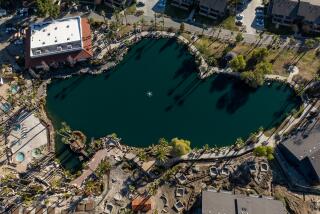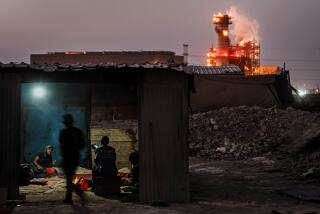Oases in Israel : Relaxing at three comfort zones in the harsh desert
Thereâs no place in Israel quite like Ein Gedi, an oasis where the Judean Desert meets the Dead Sea. Itâs a place of palm trees, freshwater springs and demure and mysterious mountain goats called ibexes.
There are two nature reserves, a modern kibbutz, a spa where you can cover your body in mineral-rich mud and an ancient synagogue. Archeological finds here date back to the Chalcolithic (Copper) Age, at least 5,000 years ago.
My family and I are frequent visitors to Ein Gedi, and it was here that we retreated in November 1995, on the weekend after Israeli Prime Minister Yitzhak Rabinâs assassination. We felt that we and our two boys needed to get away from our home in Jerusalem. We didnât speak of it openly, but I think both Connie and I, two Americans who had come to Israel by choice as adults in the â80s, had moments during that black week when we wondered just what we were doing here. We needed to go somewhere where we could clear our heads. It didnât take much discussion before we decided on Ein Gedi.
*
A cold, drenching rain was falling when we left Jerusalem on Friday afternoon, weather that matched the national mood. But when we arrived that evening, we found the air cool and clear. And the next morning, the sun was shining and the day warm. Though it is a mere two hoursâ drive from Tel Aviv, and less from Jerusalem, Ein Gedi is a world away from the congested center of the country.
Situated at the midway point along the western shore of the Dead Sea, it is lush only by local standards, perhaps. But its flora and the sweet water that flows year-round are in sharp contrast to the bilious body of water just across the road and the craggy cliffs of the Hebron Hills that run along the seaâs length.
There are hundreds of caves up in those hills, and it is no mere coincidence that the humidity- and moisture-free environment they offer was chosen 2,000 years ago for the storage of the Dead Sea Scrolls. The Scrolls, about 800 documents written on parchment, include some of the earliest extant copies of biblical texts as well as manuscripts that describe the life and beliefs of an ascetic group that lived between the time of the Old and New Testaments.
There are many surprises and mysteries at Ein Gedi. Perhaps the most enchanting is your first sighting of an ibex. Its buff-colored hide is so perfectly shaded to match and blend into the background hills that only when it moves do you realize itâs been staring at you all along.
On another recent visit, with three young boys in tow (our sons Itai, nearly 3; Avishai, 6 1/2; and his classmate, Adam), our first encounter with the wild goats took place several miles to the north of Ein Gedi, on the narrow road that heads south from Jericho. Around the curve we went and there in front of us was a herd of ibexes sauntering across the path.
Two generations ago, these majestic wild goats were near extinction. Today, because of preservation efforts, they are abundant, even approachable. But as close as they allow one to get, they retain an elusive quality, less fearful, Iâd say, than shy.
It is little surprise, then, that none other than God refers to the secretive ways of the ibex in bearing its young. Appearing to Job from out of the whirlwind, God scolds him for presuming to understand the ways of the universe, and asking: âKnowest thou the time when the wild goats of the rock bring forth?â (Job 39:1) And indeed, when the time comes for these fleet-footed ruminants to give birth, they disappear into those same hills that stand guard to the west of the Dead Sea; no human has ever witnessed an ibex in labor. Or so they say.
The name Ein Gedi, which in Hebrew means âspring of the kidâ (as in baby goat), refers to one of four springs that flow year-round from a height of about 650 feet up in the mountains, feeding the oasis. Two of the other springs, Nahal Arugot and Nahal David, create the two nature reserves in the vicinity. (Nahal is Hebrew for wadi, itself an Arabic word that describes the ravines that run from the mountains to the sea, that are dry and perfect for hiking except when winter rains cause them to flash flood.)
*
Due north of the reserves is a field school run by Israelâs remarkably active Society for the Preservation of Nature, and an adjacent youth hostel, both of them clean but modest in fittings and prices, and both open to the general public. Just south of the reserves, on a hill overlooking the Dead Sea and facing the reddish hills of Biblical Moab in Jordan, is the modern-day Kibbutz Ein Gedi, which celebrated its 40th anniversary this year.
Though it still grows dates, the kibbutz derives most of its income from its tourism facilities: a guest house; campgrounds; beaches along the salty, buoyant Dead Sea; a boat that takes visitors for 70-minute cruises around the Israeli side of the sea; and a spa a few miles to the south. The spa is very much nonexclusive. And for less than $15, you can spend the day in its sulfur baths and saltwater pools, or smearing mud all over your body.
I have to admit Iâve only stopped at the spa to eat at its cafeteria restaurant, but Connie swears that the mud, when left to dry on the skin under the desert sun before being rinsed off, leaves the epidermis feeling like velvet for days.
Farther south is the mammoth plant of the Dead Sea Works, which looks like the kind of place that in a science-fiction movie is kept running by slave labor. It extracts a half-billion dollarsâ worth of magnesium chloride, bromine and various salts from the sea each year and ships them around the world.
What remains at Ein Gedi from the Copper Age are the remnants of the only temple that has been found in the Judean Desert, dating from 4 1/2 milleniums ago. Ashes and bones from animal sacrifices have been found at the site, but most archeologists agree that the most impressive artifacts were transferred in antiquity, perhaps because the site was under attack, to a cave six miles to the south at Nahal Mishmar, to be discovered in 1961.
Called the Judean Desert Treasure, the cache consisted of more than 400 copper items: crowns, scepters and a variety of other beautiful objects, some shaped like ibexes. None have any clear practical function, which is why theyâre assumed to be ritual objects and have been associated with the Ein Gedi temple. On display today at the Israel Museum in Jerusalem, the objects are shockingly sophisticated, and so beautiful and unusually shaped that you get chills just looking at them and considering how old they are.
Later, the Bible tells us that David, fleeing from Saul, took refuge âin the wilderness of Ein Gediâ (I Samuel 24) but was pursued by the king to the spot where the two had a tearful reconciliation--the first of several. From the First Temple era to Byzantine times (6th century BC to the 6th century AD), Ein Gedi was more than mere wilderness because there was continuous Jewish settlement there during that period. And though there have been a variety of excavations at the site over the years, it was only in January that a comprehensive dig of the ancient village began, sponsored by Hebrew University and the University of Hartford, and expected to last into the next century.
*
A trip to the Dead Sea area that includes Ein Gedi means a descent to a different clime, to the lowest point on Earth, about 1,300 feet below sea level. In the summer, temperatures can exceed 110 degrees Fahrenheit; in the winter, when the rest of the country is more often than not rainy and raw, Ein Gedi is dry and often balmy. It may not be hot enough for sunbathing, but the nature reserves are perfect for hiking and offer a variety of paths through strikingly beautiful canyons that are appropriate for even the out-of-shape among us.
During the summer high season, hordes of tour groups pass through Ein Gedi to frolic in the waterfall at Nahal David on their way back from day trips to the mountain fortress of Masada about 10 miles south. But on a fall or winter weekend thereâs something uniquely Israeli about the experience.
Even as Israel becomes a more individualistic society, the venerated tradition of group outings is still popular. Itâs not uncommon for bunches of families, colleagues and/or kibbutzniks to hire a bus and a guide and travel to an archeological or nature site for a few hours of rigorous hiking, usually followed by a picnic of grilled meats and eggplant salads prepared in ways you may never have dreamed of.
*
Ein Gedi is ideal for a day trip from Jerusalem or even Tel Aviv, but there is more than enough to do there to justify an overnight stay. Though none of the accommodations in the area are deluxe, if luxury housing is a must there are two concentrations of high-rise hotels an additional half an hour or so to the south--at Ein Bokek and Neve Zohar.
Some of these are as pampering as Israeli hotels get, with prices to suit the services. (Typical double rooms at two of the fanciest, the Moriah and the Nirvana, range from $260 to $305 a night, including breakfast.)
But none of them has the charm of the Ein Gedi kibbutz guest house which, true to its oasis location, is surrounded by a lush, surprising variety of vegetation (including the trademark date palms) highlighted against the stark desert mountains. The modesty of the rooms, with their narrow single beds, is easily offset (unless perhaps youâre on your honeymoon) by the kibbutzâs manicured lawns, its small zoo, a slew of playgrounds, indoor and outdoor pools, and childrenâs activities. The rooms have private bathrooms with showers, TVs and refrigerators. The food in the guest dining hall is adequate and abundant, but as with food in most Israeli hotels, nothing to write a travel article about.
One of the archeological sites at Ein Gedi that was excavated in the 1970s is the ancient synagogue, which was in use for about 400 years, from the 3rd century AD to late in the 6th century. Interestingly, two different mosaic floors were laid in the hall, one on top of the other. The site was recently renovated and a fancy canopy installed over the mosaics, but bureaucratic haggling over maintenance has so far prevented its official reopening.
If youâre traveling in the area with children, all the tales of archeological conundrums and beautiful views may pale next to the essential question: Will a visit to Ein Gedi keep the kids occupied?
Ein Gedi has two ingredients that have proved to be a source of entertainment to most children I know under 15 (and a lot of adults too): water and animals. Besides the elusive ibexes, one is almost certain to see the furry little hyraxes, or rock rabbits. And the nature reserves claim to have hyenas and four leopards on the premises as well, though I can almost promise you wonât see them.
As for the water, a float in the Dead Sea is always a source of laughs, unless you have open cuts on your body or have recently shaved your legs. And within the reserves, the capacity of children to stand by the side of a stream, throwing rocks into it without their interest flagging, is for me the greatest of all Ein Gediâs mysteries.
(BEGIN TEXT OF INFOBOX / INFOGRAPHIC)
GUIDEBOOK: Natural Ein Gedi
Getting there: Ein Gedi is easily accessible by car from Jerusalem; the Dead Sea road that goes there also is the way to the mountain fortress of Masada and, much farther south, to Eilat. The drive does take you through the West Bank on the stretch from Jerusalem to the northern tip of the Dead Sea, but the road does not pass through any towns and is generally considered safe from a security point of view. If there is something to fear, it may be your fellow drivers. Take special care on the narrow, winding Dead Sea roads.
The national bus cooperative Egged offers regular service from Jerusalem on the same road for about $13 round trip. From Tel Aviv, thereâs one bus a day for a round-trip price of $31. (Eggedâs telephone in Jerusalem, 011-972- 2-530-4555; Tel Aviv, 011-972-3-537-5555.)
What to do: Entrance to either of the nature reserves, Nahal David or Nahal Arugot, is $3.10 for adults, $1.75 for children ages 5-18; one ticket is good all day and allows entrance to both parks (local telephone, 07-658- 4285). Entrance to the Ein Gedi Spa is about $14 (slightly more on Saturdays) for adults, $11 for children. Services such as massages and facials are extra (tel. 07-659-4934).
Where to stay: The nicest accommodations are at the kibbutz guest house, the equivalent of a mid-range hotel. Rooms during low season (January, February, July to September and December) cost $174 a night, based on double occupancy, breakfast and one other meal included; in high season (March to May, October and November), $204 a night. Price includes entrance to the spa down the road and activities offered by the kibbutz (tel. from the U.S., 011-972-7- 659-4222).
Rooms at the Ein Gedi Field School are spartan but not unpleasant, with private bathrooms. Rates: about $80 double occupancy, including breakfast. Dinners also can be arranged (tel. 011-972-7- 658-4350, 658-4288). Next door is the youth hostel, where you can sleep dormitory-style for $15 a night, breakfast included, or in a private room, double occupancy, for $42 (tel. 011-972-7-658-4165).
Where to eat: Non-guests can purchase meals in the dining halls mentioned above, and the kibbutz runs a self-service restaurant.
--D.G.
More to Read
Sign up for The Wild
Weâll help you find the best places to hike, bike and run, as well as the perfect silent spots for meditation and yoga.
You may occasionally receive promotional content from the Los Angeles Times.






